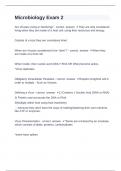-
1. Exam (elaborations) - Bacteria questions with complete solution
-
2. Exam (elaborations) - Beginners microbiology question and answers 100% correct
-
3. Exam (elaborations) - Ch 1: history of microbiology question and answers verified to pass
-
4. Exam (elaborations) - Chapter 1 introduction to microbiology questions with complete solution
-
5. Exam (elaborations) - Chapter 1 study guide microbiology question and answers rated a+
-
6. Exam (elaborations) - Chapter21 question and answers 100% correct
-
7. Exam (elaborations) - Exams microbiology question and answers already passed
-
8. Exam (elaborations) - Fundamentals of microbiology question and answers verified to pass
-
9. Exam (elaborations) - History of microbiology questions with complete solution
-
10. Exam (elaborations) - History of microbiology question and answers rated a+
-
11. Exam (elaborations) - Medical microbiology question and answers already passed
-
12. Exam (elaborations) - Microbiology question and answers correctly solved
-
13. Exam (elaborations) - Microbiology questions with complete solution
-
14. Exam (elaborations) - Microbiology question and answers rated a+
-
15. Exam (elaborations) - Microbiology question and answers rated a+
-
16. Exam (elaborations) - Microbiology question and answers 100% correct
-
17. Exam (elaborations) - Microbiology question and answers correctly solved
-
18. Exam (elaborations) - Microbiology boc questions with complete solution
-
19. Exam (elaborations) - Microbiology question and answers rated a+
-
20. Exam (elaborations) - Microbiology chapter 1 microbes question and answers 100% correct
-
21. Exam (elaborations) - Microbiology chapter 3 question and answers already passed
-
22. Exam (elaborations) - Microbiology class question and answers verified to pass
-
23. Exam (elaborations) - Microbiology question and answers correctly solved
-
24. Exam (elaborations) - Microbiology definitions questions with complete solution
-
25. Exam (elaborations) - Microbiology question and answers already passed
-
26. Exam (elaborations) - Microbiology exam 1 question and answers verified to pass
-
27. Exam (elaborations) - Microbiology exam 1 chapters 1 question and answers verified to pass
-
28. Exam (elaborations) - Microbiology exam 1 slides questions with complete solution
-
29. Exam (elaborations) - Microbiology exam 1 question and answers rated a+
-
30. Exam (elaborations) - Microbiology exam 1 question and answers 100% correct
-
31. Exam (elaborations) - Microbiology exam 1 question and answers already passed
-
32. Exam (elaborations) - Microbiology exam 1 questions with complete solution
-
33. Exam (elaborations) - Microbiology exam 2 question and answers already passed
-
34. Exam (elaborations) - Microbiology exam question and answers rated a+
-
35. Exam (elaborations) - Microbiology question and answers already passed
-
36. Exam (elaborations) - Microbiology final exam question and answers already passed
-
37. Exam (elaborations) - Microbiology for dummies chapter 1 question and answers verified to pass
-
38. Exam (elaborations) - Microbiology fundamentals question and answers rated a+
-
39. Exam (elaborations) - Microbiology questions with complete solution
-
40. Exam (elaborations) - Microbiology lab final exam question and answers already passed
-
41. Exam (elaborations) - Microbiology modules questions with complete solution
-
42. Exam (elaborations) - Microbiology organisms question and answers already passed
-
43. Exam (elaborations) - Microbiology terms question and answers already passed
-
44. Exam (elaborations) - Microbiology ucsd question and answers correctly solved
-
45. Exam (elaborations) - Microbiology unit 1 exam question and answers verified to pass
-
46. Exam (elaborations) - Microbiology question and answers correctly solved
-
47. Exam (elaborations) - Microbiology question and answers already passed
-
48. Exam (elaborations) - Microbiology question and answers verified to pass
-
49. Exam (elaborations) - Microbiology question and answers correctly solved
-
50. Exam (elaborations) - Microbiology questions with complete solution
-
51. Exam (elaborations) - Microbiology question and answers rated a+
-
52. Exam (elaborations) - Microbiology question and answers already passed
-
53. Exam (elaborations) - Microbiology question and answers rated a+
-
54. Exam (elaborations) - Microbiology question and and answers already passed
-
55. Exam (elaborations) - Microbiology question and answers verified to pass
-
56. Exam (elaborations) - Microbiology question and answers correctly solved
-
57. Exam (elaborations) - Overview of microbiology questions with complete solution
-
58. Exam (elaborations) - Principles of microbiology question and answers 100% correct
-
59. Exam (elaborations) - Principles of microbiology question and answers correctly solved
-
60. Exam (elaborations) - The science of microbiology questions with complete solution
-
Show more




